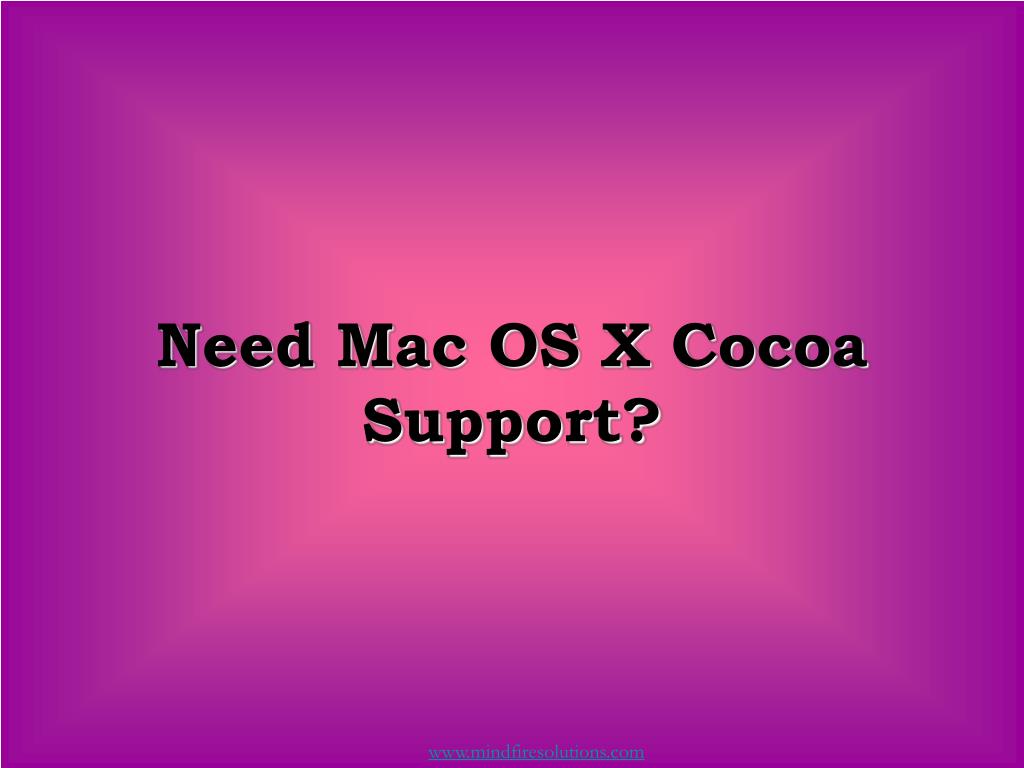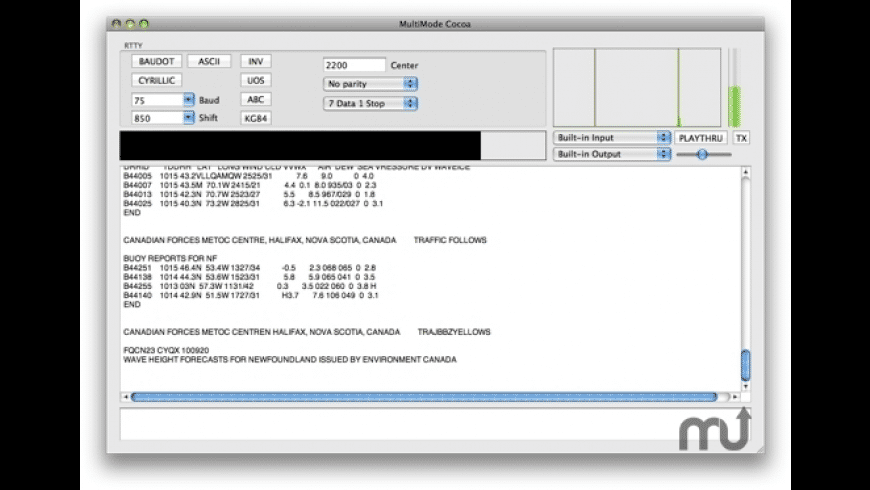With the first label being in place, the second quite common Cocoa control used in macOS apps is the text field. It’s a NSTextField object, and its purpose is to enable apps receiving user input when necessary. A text field is a single-line text input control, so if you want multiple lines of text you’d better pick a text view instead. The Dependency Manager for iOS & Mac projects. CocoaPods is a dependency manager for Swift and Objective-C Cocoa projects.
This document is the starting point for learning how to create Mac apps. It contains fundamental information about the OS X environment and how your apps interact with that environment. It also contains important information about the architecture of Mac apps and tips for designing key parts of your app.
At a Glance
Cocoa is the application environment that unlocks the full power of OS X. Cocoa provides APIs, libraries, and runtimes that help you create fast, exciting apps that automatically inherit the beautiful look and feel of OS X, as well as standard behaviors users expect.
Cocoa Helps You Create Great Apps for OS X
You write apps for OS X using Cocoa, which provides a significant amount of infrastructure for your program. Fundamental design patterns are used throughout Cocoa to enable your app to interface seamlessly with subsystem frameworks, and core application objects provide key behaviors to support simplicity and extensibility in app architecture. Key parts of the Cocoa environment are designed particularly to support ease of use, one of the most important aspects of successful Mac apps. Many apps should adopt iCloud to provide a more coherent user experience by eliminating the need to synchronize data explicitly between devices.

Relevant Chapters:The Mac Application Environment, The Core App Design, and Integrating iCloud Support Into Your App
Common Behaviors Make Apps Complete
During the design phase of creating your app, you need to think about how to implement certain features that users expect in well-formed Mac apps. Integrating these features into your app architecture can have an impact on the user experience: accessibility, preferences, Spotlight, services, resolution independence, fast user switching, and the Dock. Enabling your app to assume full-screen mode, taking over the entire screen, provides users with a more immersive, cinematic experience and enables them to concentrate fully on their content without distractions.
Relevant Chapters:Supporting Common App Behaviors and Implementing the Full-Screen Experience
Get It Right: Meet System and App Store Requirements
Configuring your app properly is an important part of the development process. Mac apps use a structured directory called a bundle to manage their code and resource files. And although most of the files are custom and exist to support your app, some are required by the system or the App Store and must be configured properly. The application bundle also contains the resources you need to provide to internationalize your app to support multiple languages.
Apple Cocoa
Finish Your App with Performance Tuning
As you develop your app and your project code stabilizes, you can begin performance tuning. Of course, you want your app to launch and respond to the user’s commands as quickly as possible. A responsive app fits easily into the user’s workflow and gives an impression of being well crafted. You can improve the performance of your app by speeding up launch time and decreasing your app’s code footprint.
Relevant Chapter:Tuning for Performance and Responsiveness
How to Use This Document

This guide introduces you to the most important technologies that go into writing an app. In this guide you will see the whole landscape of what's needed to write one. That is, this guide shows you all the 'pieces' you need and how they fit together. There are important aspects of app design that this guide does not cover, such as user interface design. However, this guide includes many links to other documents that provide details about the technologies it introduces, as well as links to tutorials that provide a hands-on approach.
In addition, this guide emphasizes certain technologies introduced in OS X v10.7, which provide essential capabilities that set your app apart from older ones and give it remarkable ease of use, bringing some of the best features from iOS to OS X.
See Also
The following documents provide additional information about designing Mac apps, as well as more details about topics covered in this document:
To work through a tutorial showing you how to create a Cocoa app, see Start Developing Mac Apps Today.
For information about user interface design enabling you to create effective apps using OS X, see OS X Human Interface Guidelines.
To understand how to create an explicit app ID, create provisioning profiles, and enable the correct entitlements for your application, so you can sell your application through the Mac App Store or use iCloud storage, see App Distribution Guide.
For a general survey of OS X technologies, see Mac Technology Overview.
To understand how to implement a document-based app, see Document-Based App Programming Guide for Mac.
Copyright © 2015 Apple Inc. All Rights Reserved. Terms of Use | Privacy Policy | Updated: 2015-03-09
cocoaModem 2.0
cocoaModem is a Mac OS X application which implements modems (modulator-demodulators) for some of the Amateur Radio modulation modes. cocoaModem’s name is a reference to the MacOS X Cocoa framework that it uses.
The cocoaModem application is free and can be downloaded from the Downloads tab at the top of this page. cocoaModem is built as a Universal Binary and runs natively on both Intel based and PowerPC based Macintosh computers and is localized for Japanese Mac OS X.
An online User's Manual is available through the User's Manual tab above. The What's New page lists what has changed since the previously released version of cocoaModem.
cocoaModem 2.0 works under Mac OS X 10.4 (Tiger), Mac OS X 10.5 (Leopard), Mac OS X 10.6 (Snow Leopard) and Mac OS X 10.7 (Lion).
cocoaModem 2.0 currently supports the following modulation modes and interfaces
- RTTY (AFSK or FSK) basic RTTY interface
narrowband two-receiver RTTY interface
wideband two-receiver RTTY interface - PSKBPSK31
QPSK31
BPSK63
QPSK63
BPSK125
QPSK125 - MFSKMFSK16
DominoEX 4
DominoEX 5
DominoEX 8
DominoEX 11
DominoEX 16
DominoEX 22 - Hellschreiber
- CWwideband two-receiver CW interface
- ASCII Radioteletype
- SITOR-B reception
- HF-FAX reception
- Synchronous AM reception
Cocoa Mac Os

Mac Cocoa Downloads
 There is also a basic contest interface in cocoaModem for the RTTY and PSK modes. The contest interface is not meant for serious contesting; it provides a simple interface for casual exchanges in a contest and provides Cabrillo export for a few digital mode contests.
There is also a basic contest interface in cocoaModem for the RTTY and PSK modes. The contest interface is not meant for serious contesting; it provides a simple interface for casual exchanges in a contest and provides Cabrillo export for a few digital mode contests. Nao, JF1WWZ created the Japanese translation and localization files.
For addtional information on Push-to-Talk (PTT), please refer to this page.
cocoaModem started out as a program for me to work RTTY and PSK modes using Mac OS, and it grew into a software platform that I use for other DSP and user interface experiments.
Some demodulation algorithms (such as the multiple soft decoders in RTTY) and user interfaces (such as the 'click buffer') are unique to cocoaModem, but you will at the same time not find every one of the major digital modes used in Amateur Radio implemented here.
cocoaModem is neither a supported product nor a finished product. I try to keep the documentation up to date so that others can also use the application if they have similar requirements and equipment setups as mine. For those that don't have the same requirements, the source code for cocoaModem is open for anyone to make modifications for themselves. Please consider each release of cocoaModem simply as a checkpoint of the code that I am continuously experimenting with.
In addition to the application itself, the source code for the application and cocoaModem's frameworks (under Creative Commons copyright) are also available free for non-commercial use. The cocoaModem Xcode project with sources is available through the download page..
cocoaModem 2.0 requires at least MacOS X 10.4 (Tiger) to function properly, and continues to work with Mac OS X 10.5 (Leopard), Mac OS X 10.6 (Snow Leopard) and Mac OS X 10.7 (Lion).
Mac Sweet As Cocoa
 Older versions of cocoaModem are available for use with the older MacOS X 10.2 (Jaguar) and MacOS X 10.3 (Panther) operating systems, but they do not incorporate all the features mention in the current manual. You can find them in the same download page that was mentioned above.
Older versions of cocoaModem are available for use with the older MacOS X 10.2 (Jaguar) and MacOS X 10.3 (Panther) operating systems, but they do not incorporate all the features mention in the current manual. You can find them in the same download page that was mentioned above. 